Shep Hyken's Blog, page 186
July 13, 2016
Six Reasons You Shouldn’t Lie to a Customer
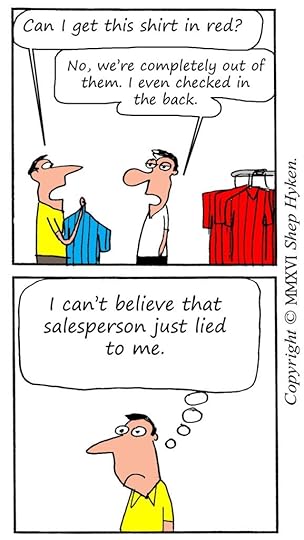 Customer Experience
Customer ExperienceWe had a reservation Friday night at a restaurant for 7:30. We arrived on time, if not a few minutes early. There were two tables that were available, right in the middle of the restaurant. However, the hostess was looking in other parts of the restaurant. I pointed at one of the open tables and asked if we could sit there. She said, “No. That table is for six people.” Maybe I can’t count, but from what I could tell, the table was set for four in the middle of restaurant that was jammed with tables. There was no way they could put six chairs around it. So, I asked her how she could put six chairs around that table. She thought for a moment and decided to change her story. She said, “Actually that table is being held on request for a party coming in with an 8:00 reservation.”
I knew she was making up excuses to not give me that table and wasn’t sure why. I could believe that someone requested a specific table, but why would she lie about holding it for six people? I looked at her and asked her, “So, which is it? Are you changing it over to a six top or are you holding it for a guest that requested it?”
She knew she’d been caught in a lie, and decided to get her manager. I watched and could see she was explaining to him what happened. This was going to be interesting. I thought, what “story” was he going to tell me? Was he going to back her up to save face? Was he going to let me sit in one of the open tables? Or, was I going to decide I didn’t like being lied to and leave to go to another restaurant?
Well, the manager was very pleasant. He sat us at one of the open tables, and I thanked him. I shared the story with him and he shook his head in disappointment. He apologized profusely and thanked me for coming to the restaurant.
There is a big lesson here, and it’s very simple: Don’t lie to the customer. If you’re caught in a lie, it could cost you in a number of ways:
It’s embarrassing.
You lose credibility and trust with the customer.
It can give you a bad reputation as an individual.
It can reflect poorly on your company’s reputation.
Unless you own the company, it could cost you your job.
And finally, the customer may leave and never come back.
For all of the reasons above, and a few more I’m sure, you don’t want to lie. A lie will come back to you in only negative ways. Being labeled a liar is not what you want to be known for. You won’t find people saying he or she is a good person and a wonderful liar.
Shep Hyken is a customer service expert, keynote speaker and New York Times bestselling business author. For information contact or www.hyken.com. For information on The Customer Focus™ customer service training programs go to www.thecustomerfocus.com. Follow on Twitter: @Hyken
(Copyright © MMXVI, Shep Hyken)
Save
Save
Save
Save
Save
Save
Save
The post Six Reasons You Shouldn’t Lie to a Customer appeared first on Shep Hyken.
July 12, 2016
Amazing Business Radio: Tricia Morris
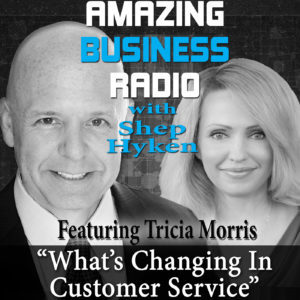 Tricia Morris On What’s Changing In Customer Service
Tricia Morris On What’s Changing In Customer ServiceShep Hyken speaks with customer service thought leader, author, Sr. Product Manager at Microsoft, and one of the top customer service influencers of 2016, Tricia Morris, about global customer service. Tricia shares stats and facts from Microsoft’s State of Global Customer Service Report and how customer service is changing globally. They talk about how customer expectations are changing, and just as important, what customer support centers are doing about those changes. This is must-have information to help you navigate the ever changing world of customer service.
Click here to listen and subscribe to Amazing Business Radio on iTunes.
“(Great brands and companies) have raised the bar on customer service, and people aren’t willing to accept middle of the road or mediocre service.” -Tricia Morris
Save
The post Amazing Business Radio: Tricia Morris appeared first on Shep Hyken.
July 11, 2016
5 Top Customer Service Articles For the Week of July 11, 2016
Each week I read a number of customer service articles from various online resources. Here are my top five picks from last week. I have added my comment about each article and would like to hear what you think too.
“Oh when you smilin’, when you smilin’ The whole world smiles with you” – do happy customers = better customer experiences? by Ian Golding
(I J Golding) I make no secret of the fact that I am a fan of ‘old fashioned values’ in the delivery of great Customer Experiences. Championed by the most customer centric brands in the world, such as the Ritz Carlton, the importance yet simplicity of ‘pleases’ and ‘thank yous’ cannot be underestimated in the effect they can have on customers and the way they are made to feel in their daily interactions with organisations and their people. I have written about this subject in the past – yet I assure you this blog post is not a rehash of previous ramblings. I want to tackle the subject from the other way round – not employees or staff displaying politeness and good manners to customers, but customers doing exactly the same thing to employees.
My Comment: The old saying goes that the squeaky wheel gets the oil. That means the loud and complaining customer may get more attention than one who quietly and politely complaints. Unfortunate, but often true. Well, a friendly smile can also get the oil. This article is not about how a company gives better service with a smile, but how a customer gets better service with a smile.
Maritz Motivation Solutions: Six Questions to Ask Before Launching a Loyalty Program by PR Web
(Maritz Motivation Solutions) Maritz Motivation Solutions, a leader in providing consumer loyalty programs to US and global companies for more than 30 years, has released the Insider’s Guide to Customer Loyalty, providing insight and tips on loyalty programs for marketers and brands.
My Comment: While this is a press release put out by Maritz, it links to a free download of “The Insider’s Guide to Customer Loyalty.” Well worth your attention, especially if you have any type of customer loyalty program.
6 Quick Tips To Improve Every Customer Support Email You Send by Jack Plantin
(SupportYourApp) Working in customer support, it can be easy to forget the power that each email has to impact a customer’s experience after you’ve been writing them all day. Here are 6 tips that can help you write a perfect customer support email every time.
My Comment: Great article on how to properly use email for customer service. It continues to be a popular way for customers to interact/connect with companies, which is why you should pay close attention to these simple customer service email tips. I would also add a sixth tip, which is to act with urgency. If a customer emails us, it shouldn’t take five hours for us to respond. (Otherwise, I would have waited five hours to ask for help!)
Want Customer Loyalty? Don’t ‘Nickel-and-Dime’ Them by Tom Hoffman
(CustomerThink) One of the most infuriating things for customers is when they are hit with hidden or unexpected fees. Prime examples include being slapped with a double ATM fee for a cash withdrawal (the fee charged when you use an out-of-network ATM and then the penalty that your own bank imposes). Or when a hotel charges separate WiFi fees for each device that’s used. One of my favorites is the convenience fee that’s levied when ordering concert or other types of entertainment tickets online. On the flip side, consider the goodwill and loyalty that’s generated when a company provides assistance to a customer at no charge.
My Comment: I can’t stand it when a company “nickel and dimes” me with small extra charges. It erodes the customer experience and perception of the company. What small charges might your organization add to an invoice or check when a customer does business with you? Is the decision to charge for these “extras” a customer-focused or company-focused decision. This article will make you think about the extras you may or may be charging your customers.
The most important thing to know about customer experience competencies by Jeanne Bliss
(Customer Bliss) Customer experience work is often tremendously reactionary. Leaders are responding to the last round of surveys. That doesn’t work. The goal is to move past that and create an actual engine that drives growth and hits your business goals.
My Comment: Jeanne Bliss is one of the top CX experts. When she writes, I read. And, you should too. In this article she shares some ideas about customer experience competencies. I’m especially partial to the third competency, which has to do with listening.
Shep Hyken is a customer service expert, professional speaker and New York Times bestselling business author. For information contact or www.hyken.com . For information on The Customer Focus™ customer service training programs go to www.thecustomerfocus.com . Follow on Twitter: @Hyken
Save
Save
The post 5 Top Customer Service Articles For the Week of July 11, 2016 appeared first on Shep Hyken.
July 8, 2016
Guest Blog: My Best Examples of Customer Experience Stories
This week on our Friends on Friday guest blog post my colleague, Mike Schoultz shares a few customer experience stories that demonstrate how companies have handled customer experiences, some well and some not so well. It is so important for employees to feel that they can make good customer focused decisions in every situation. – Shep Hyken
The key is to set realistic customer expectations, and then not to just meet them, but to exceed them— preferably in unexpected and helpful ways.
—Richard Branson
How many of you consider customer service or customer experience as elements of your marketing? Are customer experience stories growing in your companies’ marketing? And therefore are enablers for your word of mouth marketing strategy?
Consider this … if done well; don’t you think both could create things for customers to talk about?
Let me share a story with you as an example.
Recently I took my sister to our local credit union branch office to take care of three different transactions: getting a credit card reactivated, depositing coins, and ordering checks. The coins required a visit, but the other two transactions could have been done by phone or maybe online. I hoped one visit to a local branch would be easier, but deep down I feared it wouldn’t.
Frankly, I expected we’d be shuttled around the branch to different people to take care of each transaction. Or, worse, told to use the phone to call the credit card support number directly.
Instead, it turned into a quick and extraordinary experience. Because when we entered the branch, a banker warmly greeted us and asked how he could help. After learning what my sister needed to do, he invited us to sit down at his desk.
He then took care of everything: Called the credit card division of Wells Fargo to activate a credit card, took the coins to the teller to make the deposit and returned with a receipt, and ordered new checks. I call attention to the fact that the banker didn’t know us or how much money we had with the credit union
My perspective:
So you see how these events represent a great way to market to customers don’t you? Think I would talk about my experience with my friends and neighbors? Most definitely.
Let me share 2 more personal experiences, 1 very good and 1 not so good:
PF CHANG’S RESTAURANT
My wife and I stopped by our local P.F. Chang’s Restaurant for lunch last month. It was a beautiful Florida spring day and since it was mid-week the restaurant wasn’t too busy, so we decided to sit on the patio. However, when we asked the hostess to be seated outside we were told that it would be 15-20 minutes before we could be seated. However we could be seated immediately if we wanted to sit inside.
When I asked why we couldn’t be seated immediately … since about half the tables were open, we were told that there wasn’t enough staff scheduled on the patio to serve more tables.
Clearly this service staff did not have the decision making authority for creating good customer experiences!
My perspective:
If there were enough staff in the restaurant to serve the total number of customers, then why couldn’t they simply reallocate some of the inside staff to serve outside on the patio?
If the hostess was delegated the decision making authority to take initiate to make every customer experience a good to great one, then perhaps this might have resulted differently?
MARRIOTT
I stayed in a new Marriott Courtyard hotel a while back. The situation was that it was recently opened and should not have been opened until the problems were worked out and management was ready. There were many problems, believe me and it started as a significant customer failure.
But not only did the staff take care of the issues for me, the manager, once he got me back to ‘even’, continued to build the relationship with me. His techniques included exceptional, personalized service … using my name in face-to-face greetings, and continued follow-up and attention to detail. He actually made me believe I was the best customer he had ever had. Not only did I forget about the earlier problems, but I was feeling great about the entire three-day experience.
Service recovery requires remaining with your customer, through follow-up, and through unexpected contact well after the issue. All customers deserve our best service … but the ones that have a negative experience represent an opportunity to define a business.
Such an opportunity represents an opportunity to turn customers into enthusiasts and maybe even advocates. And that requires going beyond the ‘break-even’ point for that customer.
Research has shown time and time again that customers who reported a problem and were delighted with the outcome have higher satisfaction with the business than the ones who never experienced a problem. So these results show the importance of turning customer failure into full customer recovery.
My perspective:
Why should any company not want to seize such an opportunity?
Try it … the next time you have a customer who has had a bad experience with your business. You will be amazed at the results.
The bottom line
We need to shift our focus from identifying touch points on the consumer decision journey to enhancing experiences all the way through. While everyone loves to talk about the significance of data and technology for social media marketing, we still have yet to completely bridge the gap between crafting messages and designing experiences, have we?
Mike Schoultz is the founder of Digital Spark Marketing , a digital marketing and customer service agency. With 40 years of business experience and in his third career, he writes about topics that relate to improving the performance of business. Bookmark his blog for awesome stories and articles.
For more articles from Shep Hyken and his guest contributors go to customerserviceblog.com .
Read Shep’s latest Forbes Article: Customer Success Is Proving That The Customer Made The Right Decision To Do Business With You
Save
Save
Save
The post Guest Blog: My Best Examples of Customer Experience Stories appeared first on Shep Hyken.
July 6, 2016
A Big Trend in Customer Experience (CX): Convenience
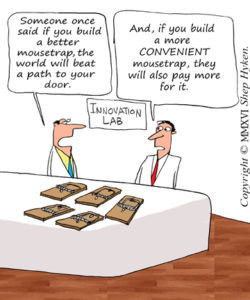 Competitive Strategy
Competitive StrategyWhat is one of the most valuable commodities in the world? Time!
There is an old saying that goes something like this: “If you build a better mousetrap, the world will beat a path to your door.” This is often attributed to Ralph Waldo Emerson and the concept of a better mousetrap is a great metaphor for a reason to continuously innovate.
In a competitive business world, price, selection, customer service and innovation are major reasons customers might choose one company over another. We can now add another concept to the mix, and that is convenience. (And, by the way, the reason I included innovation to my mix of competitive reasons is that it takes innovation to create convenience.)
Many will argue that convenience is part of customer service or the customer experience. I’ll agree with that, but it is becoming so important, that I’m willing to separate it out. There are businesses that use convenience as their sole competitive differentiator.
There is a reason that convenience stores are called convenience stores. Think about it. They are smaller than other retailers that carry similar items. They aren’t necessarily the lowest price. Yet, somehow they don’t just survive against their larger competitors. They thrive. Why? Because they are convenient. They are in the neighborhood. They are on the way to or from work or on the right side of the street. They aren’t as crowded, so a customer can get in and out much quicker. For what they lack in the selection of merchandise, they make up for in convenience.
If you want to learn about how a company competes on convenience, take a look at one of the biggest companies on the planet, Amazon. They are a case study for convenience.
When you think of Amazon, you might think of low prices and big selection. I can name dozens of other companies, both online and brick-and-mortar that do the same thing. Amazon knows it competes with all retailers. So, they broke out of the low price and big selection game with convenience. They want to save time and make life easier for their customers. They created the Amazon Prime program that gets merchandise shipped to you, without shipping charges, in two days or less. They created the Dash button that allows you to purchase merchandise with the simple push of a button. They want to eliminate as many steps as possible from the time a customer is thinking about purchasing a product until that product is delivered. And, now they are setting up distribution centers throughout major cities that can get merchandise to you in two hours or less. Speed and simplicity is what they are about.
So, regardless of the type of business you’re in, how can you create convenience for your customers? What would your customers define as convenience? Figure that out and you have another competitive strategy that will take you and your business to the next level.
Shep Hyken is a customer service expert, keynote speaker and New York Times bestselling business author. For information contact or www.hyken.com. For information on The Customer Focus™ customer service training programs go to www.thecustomerfocus.com. Follow on Twitter: @Hyken
(Copyright © MMXVI, Shep Hyken)
Save
Save
Save
Save
The post A Big Trend in Customer Experience (CX): Convenience appeared first on Shep Hyken.
July 5, 2016
Amazing Business Radio: Dan Gingiss
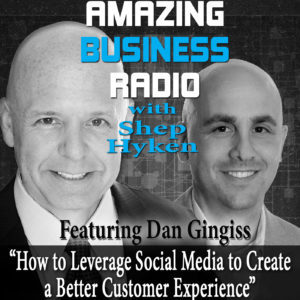
Dan Gingiss on How to Leverage Social Media to Create a Better Customer Experience
Shep Hyken discusses social customer care with Dan Gingiss, head of digital marketing for a Fortune 100 healthcare company, expert on social media & social customer care, and co-host of the “Focus on Customer Service” podcast. Dan shares his thoughts on the impact that social media is having on customer service and provides tips on how to deliver a better customer experience by using social media. There is a convergence of social media, marketing and customer service, and you can’t avoid integrating the three. So, don’t miss out on some expert advice from a social media and marketing guru!
Click here to listen and subscribe to Amazing Business Radio on iTunes.
“The digital experience is really driving the overall customer experience today.” – Dan Gingiss
Save
The post Amazing Business Radio: Dan Gingiss appeared first on Shep Hyken.
July 4, 2016
5 Top Customer Service Articles For the Week of July 4, 2016
Each week I read a number of customer service articles from various online resources. Here are my top five picks from last week. I have added my comment about each article and would like to hear what you think too.
3 Tips for Using Twitter as a Customer Service Tool by Joe Wadlington
(Hootsuite) Want to learn how to better engage with existing and potential customers on Twitter? Here are three tips to help you do just that.
My Comment: Twitter has become a viable and popular customer service channel. It’s easy for the customer (and the company), it’s fast and, most important, it’s effective. Here are three tips to using Twitter to engage with your customers, answer their questions and solve their problems.
How Employee Culture Impacts Customer Experience by Eric Berridge
(Business2Community) Since the Starbucks culture reboot of the early 2000s, coffee shop culture op-eds have become ubiquitous, but they always seem to focus on the wrong things when analyzing those customer experience successes. When I patronize a cafe, the first thing I look for is whether the baristas are happy. Forget whether they remember my name or my order, the most important question is “Do they look like they want to be there?”
My Comment: What’s happening on the inside of an organization is felt on the outside by the customers. This article proves that point. Great story backed up with some simple “how to’s” to build a customer focused culture. It starts on the inside with happy and engaged employees.
Fuel Positive Online Reviews and Leverage the Negative Ones by William Nutt
(Marketing Nutt) Customer reviews on sites like Yelp, Google and industry-specific sites can be the lifeblood of businesses across verticals. An oft-referenced survey by BrightLocal found that 92% of consumers read online reviews, 40% form an opinion based on just 1-3 reviews, and star rating is the top factor for choosing a business.
My Comment: Online reviews are a hot topic. And, these reviews aren’t just for consumer focused companies (retailers, restaurants, hotels, etc.). There are review sites for almost every industry. This article has some great ideas on how to leverage both positive and negative reviews.
The Customer Service Interview – Question & Answer Template by Pascal van Opzeeland
(Userlike) The average job interview is mightily ineffective. Hundreds of studies have taught us that much (Forbes). Instead of selecting the best person for the job, most interviews favor the applicants that are attractive, sociable, articulate, or tall.
My Comment: I’m often asked how to hire the best people for customer service positions. Well, this excellent article is full of great ideas and interview questions that you might ask a potential employee who is being hired for a customer support center – or any customer facing role.
24 People Were Asked: ‘What’s The Dumbest Customer Complaint You’ve Ever Received?’ by Laura McCallum
(Knowable) People on Reddit were asked: “What is the dumbest customer complaint you’ve ever heard?” These are some of the best answers.
My Comment: Here is a fun article about the “dumbest” customer complaints ever received. Yes, you will be stunned by how dumb (hey that rhymes) some of these are. Get ready to smile. Warning: there is some harsh language used to describe some of the complaints.
Shep Hyken is a customer service expert, professional speaker and New York Times bestselling business author. For information contact or www.hyken.com . For information on The Customer Focus™ customer service training programs go to www.thecustomerfocus.com . Follow on Twitter: @Hyken
Save
The post 5 Top Customer Service Articles For the Week of July 4, 2016 appeared first on Shep Hyken.
July 1, 2016
Guest Blog: Improve Company Culture By Listening to Your Employees
This week on our Friends on Friday guest blog post my colleague, Brooke Cade writes about how important communicating with your employees and listening to their insight is for improving company culture. One of my favorite ideas in the article is when employers enable employees to take ownership of their jobs and any issues that may present themselves.
As a business owner, “better” is always on the horizon, and you are responsible for finding the best vehicle to reach it. But what if you are ignoring your greatest resources for improvement: your frontline employees?
Feedback from customers and opinions of management can all be skewed due to a limited perspective. Frontline employees in the thick of everyday customer service may see or speak to 100+ clients a day, which gives them valuable insight into your business. Open up the line of communication with your employees to evaluate your current processes and reach your customer experience goals.
Foster the Voice of the Employee
Accepting employee suggestions and acting on them can’t be the end of it. This process is in constant motion with ebbs and flows of information. Some ideas for fostering the line of communication for your employees are:
Focus on personal awareness and understanding. Continually ask questions that allow them to express their unique strengths and their personal goals within the company.
Create training programs and professional development workshops.
Educate your employees on exactly what your company stands for and how it differentiates from similar brands, products, or institutions.
Don’t make the corporate brand and the personal brand compete. Help each employee find a way to make their individual traits contribute to the overall mission and goal of the company.
Give credit where credit is due. Don’t be afraid to implement an idea presented by an employee (if you think it’s viable) and definitely give them credit.
Enable Employees to Take Ownership
Give employees the opportunity to take ownership of their jobs. Make sure they feel like they are a part of the success of your business, and are allowed opportunities to contribute in meaningful ways. Communication is vital to this: they must know that their voice is heard, and they must consistently hear that their work is appreciated.
Ways you can open these lines of communication are:
Weekly staff meetings with agenda items suggested from employees.
Email out an “Idea of the Month” proposed by employees to then open for feedback, constructive criticism, suggestions for implementation, proposed timelines etc.
Designate engaged and dedicated employees as “Brand Ambassadors” to head the charge and collect frequent feedback.
Create Employee Resource Groups to encourage cooperation and engagement from diverse employees.
Building on Employee Perspective
To truly benefit from the voice of your employees, you need to build upon it and integrate it into your broader business communication. Don’t take what your employees say without also considering the following viewpoints:
Stakeholders – Identify your stakeholders and evaluate their perspective and experiences with what does and does not work within your company.
Managers – Managers can see the process almost as an outsider and can recognize issues not visible to employees blinded by the cogs of their customer service duties.
Team Leads – Where employees may be focused on the customer experience, team leads can see where strengths and weaknesses lay within employees and possess ideas on better training opportunities.
Assistants – Observant and dedicated assistants can provide insight on time management.
Neighboring Departments – Departments that may work closely with yours may have an external perspective on how your process affects their ability to be efficient.
The Competition – We’ve all heard, “don’t reinvent the wheel.” Take note of how your competitors foster employee engagement, or look for successful business models outside of your industry. Many of these principles are universal
Having a continual process to engage all of your employees, stakeholders, and customers will increase productivity, improve morale, and “better” your company as a whole. This process allows you to identify why things are or are not working, and ensures you learn from past mistakes and foster continual growth.
Brooke Cade is a writer who’s committed to helping businesses and sales professionals build stronger connections with their customers. In her spare time, she enjoys learning more about InMoment.com—her CX platform of choice, reading books/articles on industry news, engaging on twitter, and exploring her local neighborhood coffee shop.
For more articles from Shep Hyken and his guest contributors go to customerserviceblog.com .
Read Shep’s latest Forbes Article: Five Ways Ace Hardware Proves David Can Beat Goliath
Save
Save
The post Guest Blog: Improve Company Culture By Listening to Your Employees appeared first on Shep Hyken.
June 29, 2016
Validate Your Customers Decision to Do Business with You
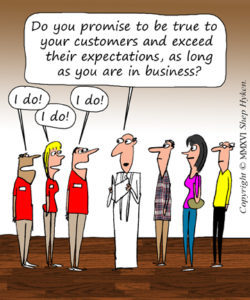 My effort to make the sale is validated when the customer chooses to do business with me. Then it is just as important, if not more so, for me to validate my customer’s choice to do business with me through what happens after the sale.
My effort to make the sale is validated when the customer chooses to do business with me. Then it is just as important, if not more so, for me to validate my customer’s choice to do business with me through what happens after the sale.
I’ve been thinking about the concept of validation for a while. This is where the customers validate your efforts in persuading them to do business with you. Sometimes the pursuit of the customer may include meetings, proposals and various other tasks. Gaining validation with a customer this way may take a year or longer. However, in some cases it happens much faster. For example, in a retail store, it may be what’s in the window that captures a new customer’s eye. Then a friendly sales person helps the customer and within minutes the sale is made, making the sale happen almost instantly. Now while this may seem more like a sales concept, stay with me. It’s all about customer service and the customer experience.
The point is that the customer is making a decision based on all types of reasons that can include brand awareness and perception, interactions with people, marketing messages and more. Everything that happens leading up to that first sale is based on the customer’s experience. At some point the customer makes the decision to buy. This is called “making the sale.” We can also call it “validating the effort.”
Then what happens after the sale is the customer service and experience that makes the customer feel like he or she made the right choice, which we can call, “validating the choice.”
The point is that the customer experience, which includes customer service, begins long before the sale is made.
Perhaps an overly simplistic way to describe this concept is that it’s like a marriage. Two people go out on the first date. If all goes well, it leads to a second date. Then a third, and so on. Then one day before you know it, there’s a marriage proposal. Everything up until that proposal was part of the courting stage. When the person asking the other to marry him or her gets yes for an answer, it validates the relationship and the effort that was put into it – from on both sides, by the way. Then once the two get married, either one – hopefully both – would look back and say, “I made the right decision.”
It’s pretty much the same in business. That period before the sale is the courting stage. The sale is made and the customer will hopefully say the same thing, “I made the right decision.”
That’s validation. And, it’s all about the customer’s experience. So, what are you consistently doing to validate the choice that your customers have made to do business with you?
Shep Hyken is a customer service expert, keynote speaker and New York Times bestselling business author. For information contact or www.hyken.com. For information on The Customer Focus™ customer service training programs go to www.thecustomerfocus.com. Follow on Twitter: @Hyken
(Copyright © MMXVI, Shep Hyken)
The post Validate Your Customers Decision to Do Business with You appeared first on Shep Hyken.
June 28, 2016
Amazing Business Radio: Jeff Lesser
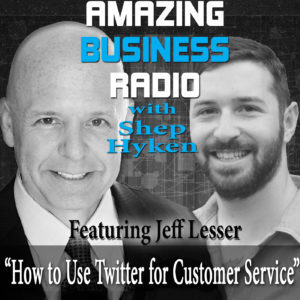
Jeff Lessor Talks about Improving Customer Service with Twitter
Shep Hyken speaks with Twitter’s Senior Marketing Manager, Jeff Lesser, about how to use Twitter for customer service. More and more customers are posting comments and questions for companies on Twitter. It is becoming a viable customer service channel as an alternative to email and the phone. Jeff shares several best practices and new tools that Twitter has created especially for customer service. They discuss how social media has greatly impacted customer service interactions between the customer and businesses, and how you can use this to your advantage. Don’t miss out on Jeff’s expert advice on how to improve customer service using Twitter!
Click here to listen and subscribe to Amazing Business Radio on iTunes.
On how social media is changing customer service: “For decades, customer service was done in the dark; people didn’t have the power to get their messages heard far and wide that they weren’t getting the customer service they needed.” – Jeff Lesser
Save
Save
The post Amazing Business Radio: Jeff Lesser appeared first on Shep Hyken.



